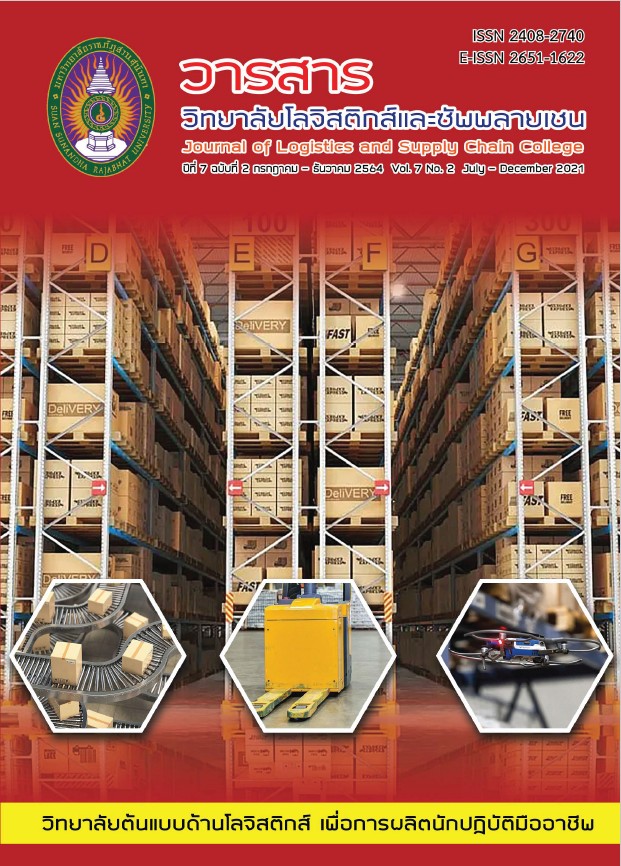The Reservation Freight Requirement of Exporters of Frozen Product To develop a reservation system for Less Container Load (LCL)
Keywords:
Booking Frozen, Ready meals, Booking Freight LCL of Reefer ContainerAbstract
The objective of this article is to 1) study the tonnage requirements of exporters for pre-made frozen meals and 2) to find out how to develop the refrigerated part of the refrigerated container reservation system of sea freight carriers. Using a research model between qualitative research and quantitative research. The 12 people interviewed and 393 surveyed were medium-sized international freight in Thai International Freight Forwarder Association. The research instrument was a questionnaire. Data was collected using specific group size and sample size methods. Data were analyzed using descriptive statistics. The results of the research were as follows: 1) Exporters' demand for tonnage divided into frozen ready-made food There is a 60% increase in the number of frozen prepared food exports from 2020. The factor in selecting the transportation method lies in the cost. There is a 1% growth rate compared between 2019 and 2020. Demand for container reservations in 2020 increase 15% with the development of the partial container reservation system, the freight will be reduced, and 2) the development of the partial frozen container reservation system. 2.1) Collection of goods is to introduce the service to the shipping agents in the country as much as possible. 2.2) The frozen container space is an arrangement of goods to use. 2.3) Freezer Storage is based on infrastructure factors, tools and equipment , human labor in container loading, are at the highest level, so utilizing the research results, shipping carriers should develop a reservation system. Refrigerated containers are partially filled according to the three guidelines mentioned.
References
กาญจนา กระจ่างสุวรรณ, ณัฐพัชร์ อารีรัชกุลกานต์ และชิตพงษ์ อัยสานนท์. (2563). การพัฒนาทักษะบุคลากรด้านโลจิสติกส์ของแผนกพิธีการศุลกากรขาเข้า บริษัท ดีเอชแอล เอ็กซ์เพรส อินเตอร์เนชั่นแนล (ประเทศไทย จํากัด. วารสารวิทยาลัยโลจิสติกส์และซัพพลายเชน, 6(2), 5-18.
เกศกนก เชื้อมหาวัน. (2561). การพัฒนาเกณฑ์มาตรฐานคุณภาพธุรกิจโลจิสติกส์ไทยประเภทผู้รับจัดการขนส่งสินค้าระหว่างประเทศ. วารสารสุทธิปริทัศน์, 6(1), 26-39.
เกียรติพงษ์ อุดมธนะธีระ. (2561). โซ่ความเย็นในอุตสาหกรรมอาหาร (Food Cold Chain). ค้นเมื่อ 5 มกราคม 2564, จาก: https://iok2u.com/index.php/article/logistics-supply-chain/292-food-cold-chain-2.
ณัฐวุฒิ วงษ์วรรณ, ณัฎภัทรศญา เศรษฐโชติสมบัติ และณัฐพัชร์ อารีรัชกุลกานต์. (2564). การเพิ่มประสิทธิภาพการจัดการคลังสินค้าโรงงานทูน่ากระป๋องด้วยระบบคลังสินค้าอัตโนมัติ. วารสารวิทยาลัยโลจิสติกส์และซัพพลายเชน, 7(1), 126-140.
ณัฎภัทรศญา เศรษฐโชติสมบัติ และประสิทธิ์ การนอก. (2563). การเพิ่มประสิทธิภาพการบริหารพื้นที่คลังสินค้าอุตสาหกรรมชิ้นส่วนยานยนต์ด้วยแนวคิดเชิงบูรณาการ: กรณีศึกษา บริษัท โตไคริคะ (ไทยแลนด์) จํากัด. วารสารวิชาการวิศวกรรมศาสตร์ ม.อบ., 13(1), 127-140.
ณัฎภัทรศญา เศรษฐโชติสมบัติ. (2559). การจัดการโลจิสติกส์และโซ่อุปทาน. วิทยาลัยจัดการโลจิสติกส์.
ปรารถนา ปรารถนาดี และคณะ. (2559). โครงการพัฒนาและส่งเสริมมาตรฐานและวิธีปฏิบัติที่ดีในการบริหารจัดการระบบโซ่ความเย็น (Cold Chain) สำหรับภาคอุตสาหกรรม. ค้นเมื่อ 5 ตุลาคม 2563, จาก: https://research.ac.th
ปริญญ์ สุรศักดิ์ศิลป (2555). การหาคำตอบเหมาะที่สุดในการจัดเรียงสินค้าเพื่อทำให้ต้นทุนการเช่าตู้คอนเทนเนอร์ต่ำที่สุด. ค้นเมื่อ 2 กันยายน 2563, จาก: http://research.ku.ac.th
พีระพรรณ ภูมิดี, ฉัตรรัตน์ โหตระไวศยะ และชณิชา หมอยาดี. (2563). การปรับปรุงการจัดเก็บและควบคุมสต็อกสินค้าแผนกฟู้ดของบริษัทท็อปส์มาร์เก็ต ด้วยแนวคิดลีนเพื่อลดการสูญเสีย. วารสารวิทยาลัยโลจิสติกส์และซัพพลายเชน, 6(2),75-88.
รุจิรา เพียโคตร. (2561). การพยากรณ์ผลกระทบต่ออัตราค่าขนส่งตู้คอนเทนเนอร์ทางเรือ โดยการวิเคราะห์ถดถอยพหุคูณ. ค้นเมื่อ 15 ธันวาคม 2563. จาก: http://www.mbaoneday-abstract.ru.ac.th/ .
ศูนย์เทคโนโลยีสารสนเทศและการสื่อสาร สำนักงานปลัดกระทรวงพาณิชย์. (2563). สืบค้นเมื่อ 2 กันยายน 2563, จาก http://ictc.ops.moc.go.th
เศรษฐศาสตร์พาณิชยนาวี. (2557). มหาวิทยาลัยราชภัฎสวนสุนันทา.การขนส่งสำหรับการค้าระหว่างประเทศ (Transportations For International Trade) ค้นเมื่อ 4 มกราคม 2564, จาก: http://www.elcls.ssru.ac.th/bunyaporn_po/pluginfile.php/142/block_html/content/เอกสารประกอบการเรียนเศรษฐศาสตร์พาณิชยนาวี%20.pdf
สำนักงานสภาพัฒนาการเศรษฐกิจและสังคมแห่งชาติ. (2563). ค้นเมื่อ 24 กันยายน 2563, จาก: www.nesdc.go.th.
สลิสา พึ่งพุทธิกานต์, อดุลย์ นงภา และรพี อุดมทรัพย์. (2561). การเพิ่มประสิทธิภาพการบรรจุสินค้าในตู้คอนเทนเนอร์ กรณีศึกษาบริษัทผลิตชิ้นส่วนยานยนต์. รายงานสืบเนื่องจากการประชุมวิชาการเสนอผลงานวิจัยระดับชาติและนานาชาติ Local & Global Sustainability: Meeting the Challenges & Sharing the Solutions ครั้งที่ 9 ประจําป 2661, 1(9), 1290-1300.
สมาคมอาหารแช่เยือกแข็งไทย. (2563). สืบค้นเมื่อ 24 กันยายน 2563, จาก: www.thai-frozen.or.th
สมาคมผู้รับจัดการขนส่งสินค้าระหว่างประเทศ. (2563). สืบค้นเมื่อ 24 กันยายน 2563, จาก: www.tiffathai.org



